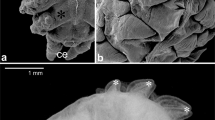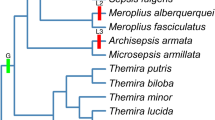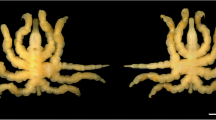Summary
The differentiation of abdominal imaginal discs of matureCalliphora erythrocephala larvae has been studied by thermocautery and extirpation of the discs, and by implanting them into larval hosts of the same age. The experiments give information on (a) the morphology of the imaginal abdomen, and (b) the “regulative activitybetween imaginal discs”.
-
1.
Within each of the first to seventh larval abdominal segments, we identified two pairs ofabdominal discs, a dorsal and a ventral one (Fig. 6). Besides, the terminal part of the abdomen holds the paired lateral genital discs and the unpaired (median) genital disc, which are of different shape in both sexes (Fig. 9, 10).
-
2.
The imaginal discs of a specific larval segment differentiate only into the integument of the corresponding imaginal segment. The dorsal pair of discs gives rise to the dorsal region (≈tergum, dorsum), the ventral pair to the ventral region of the imaginal segment (≈sternum); the left and the right discs of a larval segment develop into the corresponding halves of the segment in the adult.
-
3.
Thelateral genital discs constitute the imaginal discs of the eighth segment, while thegenital disc includes the imaginal cells of the fused segments 9–11 (Fig. 30).
-
4.
Our experimental results confirm thenumbering of segments in the imaginal abdomen, as proposed by Graham-Smith (1938), Crampton (1942), Hennig (1958), and Salzer (1968).
-
5.
The large tergites of the imaginalpreabdomen consist of an area dorsal to the spiracles, arising from the dorsal abdominal discs, and of parts lying ventral to the spiracles. These ventral parts of the tergite as well as the “pleural membranes” and the sternite originate from the ventral discs (Fig. 31).
-
6.
The small first dorsal plate of themale postabdomen proves to betergite 6. The sclerite, bordering the genital pouch ventrally, belongs to two segments; it should be termedsternite 6+7. The large sclerite, called syntergum 7+8 by Salzer (1968), is formed by several pairs of discs: the left ventral abdominal disc 6, the dorsal and ventral discs 7, and the lateral genital discs (Fig. 31). Thus, we term it thetergosternite 7+8.
-
7.
In the male only the last segments of the postabdomen participate in therotation during metamorphosis: The eighth segment is rotated through 180° (=inversion); the hypopygium (=segments 9–11) is circumverted, i.e. twisted through 360° (Fig. 31). Thus,Calliphora has no “postabdomen circumversum” as Salzer (1968) assumed, but merely a “hypopygium circumversum”.
-
8.
Our results (Fig. 32) support the current morphological interpretation of thefemale postabdomen or ovipositor, as proposed by Crampton (1942) and Hennig (1958).
-
9.
Theinternal genitalia of the male (without testes) originate from the genital disc. On the contrary, the female internal genitalia (without ovaries) develop from the lateral genital discs (oviduct, uterus, vagina, spermathecae) and the genital disc (parovaria). A comparison of the developmental capacities of theDrosophila genital disc with those of the lateral and median genital discs ofCalliphora shows that in the female ofDrosophila the equivalents of the lateral genital discs have been incorporated into the genital disc (Fig. 30).
-
10.
Afterelimination of any one of the abdominal or lateral genital discs from the mature larva, the complementary disc of the opposite side gives rise to more than accords to its prospective significance (but see the results of Zalokar, 1943, and Murphy, 1967, on cephalic and thoracic discs inDrosophila). Our data on lateral genital discs do not support the view that the reported increased differentiation is due to a “regulation between discs of a single bicentric field” (Pantelouris and Waddington, 1955). Our data may be explained more easily if we assume the existence of an inhibitory effectin situ between the discs of one pair, which is abolished after elimination of the partner (cf. chapter 6.3.).
Zusammenfassung
Um ihre Differenzierungsleistungen zu bestimmen, wurden abdominale Imaginalscheiben erwachsener Larven der SchmeißfliegeCalliphora erythrocephala thermokauterisiert, exstirpiert bzw. in gleichaltrige Wirte implantiert. Die Experimente erlauben Aussagen (a) zur Morphologie des Imaginalabdomens und (b) zum Problemkreis der „regulatorischen Aktivitätzwischen Imaginalscheiben“.
-
1.
Jedes der Abdominalsegmente 1–7 der Larve enthält 4Abdominalscheiben, ein dorsales und ein ventrales Paar (Abb. 6). Dahinter folgen die paarigen Nebengenitalscheiben und die unpaare Genitalscheibe; diese sind bei den Geschlechtern verschieden gestaltet (Abb. 9, 0).
-
2.
Die Imaginalscheiben eines bestimmten Larvalsegments differenzieren nur die Körperdecke des entsprechenden Imaginalsegments. Das dorsale Scheibenpaar bildet den dorsalen (≈ Tergum, Dorsum), das ventrale den ventralen Segmentbereich (≈ Sternum); die Scheiben einer Segmenthälfte entwickeln die entsprechende Segmenthälfte der Imago.
-
3.
DieNebengenitalscheiben erweisen sich als Imaginalscheiben des 8. Segments; dieGenitalscheibe umfaßt die Imaginalzellen der ursprünglichen Segmente 9–11 (Abb. 30).
-
4.
Die von Graham-Smith (1938), Crampton (1942), Hennig (1958) und Salzer (1968) vetreteneSegmentzählung im imaginalen Abdomen wird durch unsere experimentellen Ergebnisse bestätigt.
-
5.
Die großen Tergite desPräabdomens sind aus Teilen des dorsalen und ventralen Segmentbereichs zusammengesetzt: Die dorsal der Stigmen gelegene Tergitfläche wird von den dorsalen Abdominalscheiben gebildet; die ventral der Stigmen anschließenden Tergitteile sowie die „Pleuralmembranen“ und das Sternit entstammen den ventralen Scheiben (Abb. 31).
-
6.
Die kleine, erste Rückenplatte desmännlichen Postabdomens erweist sich alsTergit 6. Der die Genitalhöhle ventral begrenzende Sklerit gehört zwei Segmenten an; er ist alsSternit 6+7 zu bezeichnen. Am Aufbau des großen, von Salzer (1968) als Syntergum 7+8 bezeichneten Sklerits beteiligen sich: die linke ventrale Abdominalscheibe 6, die dorsalen und ventralen Scheiben 7 und die Nebengenitalscheiben (Abb. 31). Wir nennen ihn deshalbTergosternit 7+8.
-
7.
An derRotation im Verlauf der Metamorphose beteiligen sich nur die letzten Segmente des männlichen Postabdomens: Segment 8 wird um 180° gedreht, invertiert; das Hypopygium (=Segmente 9–11) erfährt eine Drehung um 360°, eine Circumversion (Abb. 31).Calliphora hat also kein „postabdomen circumversum“, wie Salzer (1968) vermutete, sondern lediglich ein „hypopygium circumversum“.
-
8.
Die bisherige morphologische Interpretation desweiblichen Postabdomens oder Ovipositors (vgl. Crampton, 1942; Hennig, 1958) wird durch unsere Befunde bestätigt (Abb. 32).
-
9.
Dieinneren Genitalien des Männchens (ohne Hoden) entstehen aus der Genitalscheibe. Dagegen werden die des Weibchens (ohne Ovarien) gemeinsam von Nebengenitalscheiben (Ovidukt, Uterus, Vagina, Spermatheken) und Genitalscheibe (Parovarien) gebildet. Vergleicht man die Entwicklungsleistungen der Genitalscheibe vonDrosophila mit denen der Nebengenital und Genitalscheiben vonCalliphora, so läßt sich folgern, daß beimDrosophila-Weibchen die Nebengenitalscheiben in die Genitalscheibe integriert worden sind (vgl. Abb. 30).
-
10.
NachAusschaltung einer Scheibe der erwachsenen Larve (dorsale, ventrale Abdominalscheibe oder Nebengenitalscheibe) differenziert die komplementäre Scheibe der anderen KörperSeite mehr als ihrer prospektiven Bedeutung entspricht. Dieses Ergebnis steht im Gegensatz zu den Befunden an Kopf und Thoraxscheiben vonDrosophila (Zalokar, 1943; Pantelouris und Waddington, 1955; Murphy, 1967). Unsere Befunde an den Nebengenitalscheiben sprechen dagegen, daß die registrierten Mehrleistungen durch eine „Regulation zwischen Scheiben eines gemeinsamen Feldes“ in Sinne von Pantelouris und Waddington zustande kommen. Sie lassen sich am besten erklären durch die Annahme einer Hemmwirkung zwischen den Scheiben eines Paaresin situ, die nach Ausschaltung des Partners entfällt (vgl. Kap. 6.3.).
Similar content being viewed by others
Abbreviations
- ++:
-
normale Ausbildung
- +:
-
leichter Schaden
- ±:
-
starker Schaden
- −:
-
Sklerit(teil) fehlt
- 1–11:
-
Abdominalsegmente
- a:
-
anterior
- Af:
-
After
- An:
-
Ansatz
- AS:
-
Abdominalscheibe (z.B. AS 6-d-li)
- BPh:
-
Basiphallus
- Ce:
-
Cercus
- Cu:
-
Cuticula
- d:
-
dorsal
- Da:
-
Enddarm
- dAp:
-
dorsale Analplatte
- De 1, 2:
-
Ductus ejaculatorius 1, 2
- E:
-
Epidermis
- eAp:
-
ejaculatorisches Apodem
- Ep:
-
Epandrium
- EPh:
-
Epiphallus
- Ex:
-
Exstirpation
- Fu:
-
Furche
- Ge:
-
Gelenk
- Gh:
-
Gelenkhöcker
- GHMb:
-
Genitalhöhlenmembran
- GÖ:
-
Genitalöffnung
- GS:
-
(mediane) Genitalscheibe
- hEpa:
-
hinterer Epandrialarm
- Ho:
-
Hoden
- Hy:
-
Hypandrium
- Hya:
-
Hypandrialarm
- HyAp:
-
Hypandrialapodem
- HyPh:
-
Hypophallus
- I:
-
Implantation
- Im:
-
Intermedium
- InMb:
-
„Intersegmental“ membran
- KB:
-
Kurzborsten
- Kla:
-
Analklappe(n)
- kLZ:
-
kleine Larvalzellen
- LB:
-
Langborsten
- Lei:
-
Leiste(n)
- li:
-
links
- LS:
-
„Lateralsäcke“ des Uterus
- M:
-
Muskel(n)
- m:
-
männlich, Männchen
- MPp:
-
Medianpapille
- msGw:
-
mesodermales Gewebe
- NGS:
-
Nebengenitalscheibe
- Od:
-
Ovidukt
- OPa:
-
Opisthoparamer
- Ov:
-
Ovar
- P:
-
Wahrscheinlichkeit
- p:
-
posterior
- Pg:
-
Paragon
- Ph:
-
Phallus
- PhAp:
-
Phallapodem
- PIMb:
-
Pleuralmembran
- Po:
-
Parovar
- pOd:
-
paariger Ovidukt
- PPa:
-
Proparamer
- PPh:
-
Paraphallus
- Prl:
-
Processus longus
- Pro:
-
Proctiger, Analfeld
- re:
-
rechts
- RLei:
-
Randleiste
- S:
-
(Imaginal-)Scheibe
- s:
-
Standardabweichung
- SP:
-
Samenpumpe
- Spt:
-
Spermathek
- SSt:
-
Surstylus
- St:
-
Sternit
- Sti:
-
Stigma
- Stl:
-
Stiel, der Genital- und Nebengenitalscheibe
- T:
-
Tergit
- T 1+2:
-
(Syn-) Tergit 1+2
- Th:
-
Thermokauterisierung
- TSt:
-
Tergosternit
- uOd:
-
unpaarer Ovidukt
- Ut:
-
Uterus
- v:
-
ventral
- vAp:
-
ventrale Analplatte
- Vd:
-
Vas deferens
- vEpa:
-
vorderer Epandrialarm
- Vg:
-
Vagina
- VPp:
-
Ventralpapille
- W:
-
Wirts
- w:
-
weiblich, Weibchen
- Wu:
-
Wulst, „Kriechwulst“
- ¯x :
-
arithm. Mittel
- ZPl:
-
Zusatzplatte
Literatur
Anderson, D. T.: The embryology ofDacus tryoni. 2. Development of imaginal discs in the embryo. J. Embryol. exp. Morph.11, 339–351 (1963).
—: The embryology ofDacus tryoni (Diptera). 3. Origins of imaginal rudiments other than the principal discs. J. Embryol. exp. Morph.12, 65–75 (1964).
Brüel, L.: Anatomie und Entwicklungsgeschichte der Geschlechtsausführwege sammt Annexen vonCalliphora erythrocephala. Zool. Jb., Abt. Anat. u. Ontog.10, 511–618 (1897).
Chillcott, J. G. T.: A comparative morphology of the male genitalia of muscoid Diptera. Proc. 10th Int. Congr. Ent. 1956,1, 587–592 (1958).
Crampton, G. C.: The external morphology of the Diptera. Connecticut Geol. Nat. Hist. Surv., Bull. No.64, 10–165 (1942).
—: A comparative morphological study of the terminalia of male calypterate cyclorrhaphous Diptera and their acalypterate relatives. Bull. Brooklyn entomol. Soc.39, 1–31 (1944).
Dübendorfer, A.: Entwicklungsleistungen transplantierter Genital-und Analanlagen vonMusca domestica undPhormia regina. Experientia (Basel)26, 1158–1160 (1970).
Emden, F. van, Hennig, W.: Diptera. In: S. L. Tuxen, Taxonomist's glossary of genitalia in insects, p. 111–122. Copenhagen: E. Munksgaard 1956.
Emmert, W.: Die Postembryonalentwicklung sekretorischer Kopfdrüsen vonFormica pratensis Retz. undApis mellifica L. (Ins., Hym.). Z. Morph. Tiere63, 1–62 (1968).
—: Entwicklungsleistungen fragmentierter Labialdrüsen-Imaginalanlagen vonFormica pratensis Retz. (Hymenoptera). Wilhelm Roux' Archiv162, 97–113 (1969).
Ephrussi, B., Beadle, G. W.: A technique of transplantation forDrosophila. Amer. Naturalist70, 218–225 (1936).
Ferris, G. F.: External morphology of the adult. In: Biology ofDrosophila, ed. M. Demerec, p. 368–419. New York: John Wiley & Sons 1950.
Feuerborn, H. J.: Das Hypopygium „inversum“ und „circumversum“ der Dipteren. Zool. Anz55, 189–212 (1922).
Gehring, W.: Übertragung und Änderung der Determinationsqualitäten in Antennenscheiben-Kulturen vonDrosophila melanogaster. J. Embryol. exp. Morph.15, 77–111 (1966).
Gleichauf, R.: Anatomie und Variabilität des Geschlechtsapparates vonDrosophila melanogaster (Meigen). Z. wiss. Zool.148, 1–66 (1936).
Gouin, F. J.: Anatomie, Histologie und Entwicklungsgeschichte der Insekten und Myriapoden. Fortschr. Zool.15, 337–353 (1963).
Graham-Smith, G. S.: The generative organs of the blow-fly,Calliphora erythrocephala L., with special reference to their musculature and movements. Parasitology30, 441–476 (1938).
Hadorn, E.: Differenzierungsleistungen wiederholt fragmentierter Teilstücke männlicher Genitalscheiben vonDrosophila melanogaster nach Kulturin vivo. Develop. Biol.7, 617–629 (1963).
—: Konstanz, Wechsel und Typus der Determination und Differenzierung in Zellen aus männlichen Genitalanlagen vonDrosophila melanogaster nach Dauerkulturin vivo. Develop. Biol.13, 424–509 (1966).
—, Bertani, G., Gallera, J.: Regulationsfähigkeit und Feldorganisation der männlichen Genital-Imaginalscheibe vonDrosophila melanogaster. Wilhelm Roux' Arch. Entwickl.-Mech. Org.144, 31–70 (1949).
—, Buck, D.: Über Entwicklungsleistungen transplantierter Teilstücke von Flügel-Imaginalscheiben vonDrosophila melanogaster. Rev. suisse Zool.69, 302–310 (1962).
—, Gloor, H.: Transplantationen zur Bestimmung des Anlagemusters in der weiblichen Genital-Imaginalscheibe vonDrosophila. Rev. suisse Zool.53, 495–501 (1946).
Hall, D. G.: The blowflies of North America. Washington: The Thomas Say Found. 1948.
Hennig, W.: Die Familien der Diptera Schizophora und ihre phylogenetischen Verwandt-schaftsbeziehungen. Beitr. Ent.8, 505–688 (1958).
Kowalevsky, A.: Beiträge zur Kenntnis der nachembryonalen Entwicklung der Musciden. I. Theil. Z. wiss. Zool.45, 542–594 (1887).
Lamprecht, J., Remensberger, P.: Polytäne Chromosomen im Bereiche der Prothoracal-dorsal-Imaginalscheibe vonDrosophila melanogaster. Experientia (Basel)22, 293–294 (1966).
Loosli, R.: Vergleich von Entwicklungspotenzen in normalen, transplantierten und mutierten Halteren-Imaginalscheiben vonDrosophila melanogaster. Develop. Biol.1, 24–64 (1959).
Lüönd, H.: Untersuchungen zur Mustergliederung in fragmentierten Primordien des männlichen Geschlechtsapparates vonDrosophila séguyi. Develop. Biol.3, 615–656 (1961).
Metcalf, C. L.: The genitalia of male syrphidae. Ann. entomol. Soc. Amer.14, 169–214 (1921).
Milani, R., Rivosecchi, L.: Malformazioni e mutazioni diMusca domestica L. di interesse per la conoseenza dei segmenti terminali maschili dei Ditteri. Boll. Zool. Ital.22, 341–372 (1955).
Mindek, G.: Proliferations und Transdeterminationsleistungen der weiblichen Genital-Imaginalscheiben vonDrosophila melanogaster nach Kulturin vivo. Wilhelm Roux' Archiv161, 249–280 (1968).
Murphy, C.: Determination of the dorsal mesothoracic disc inDrosophila. Develop. Biol.15, 368–394 (1967).
Newby, W. W.: A study of intersexes produced by a dominant mutation inDrosophila virilis, Blanco stock. Univ. Texas Publ.4228, 113–145 (1942).
Nöthiger, R.: Differenzierungsleistungen in Kombinaten, hergestellt aus Imaginalscheiben verschiedener Arten, Geschlechter und Körpersegmente vonDrosophila. Wilhelm Roux' Arch. Entwickl.-Mech. Org.155, 269–301 (1964).
—, Oberlander, H.: Differentiation of pulsating regions in genital imaginal discs after culturein vivo (Drosophila melanogaster). J. exp. Zool.164, 61–67 (1967).
—, Schubiger, G.: Developmental behaviour of fragments of symmetrical and asymmetrical imaginal discs ofDrosophila melanogaster (Diptera). J. Embryol. exp. Morph.16, 355–368 (1966).
Pantelouris, E. M., Waddington, C. H.: Regulation capacities of the wing and haltere-discs of the wild type and bithoraxDrosophila. Wilhelm Roux' Arch. Entwickl.-Mech. Org.147, 539–546 (1955).
Patton, W. S., Cushing, E. C.: Studies on the higher Diptera of medical and veterinary importance. A revision of the genera of the subfamily Calliphorinae based on a comparative study of the male and female terminalia. The genusCalliphora Robineau-Desvoidy (sens. lat.). Ann. trop. Med. Parasit.28, 205–216 (1934).
Poodry, C. A., Schneiderman, H. A.: The ultrastructure of the developing leg ofDrosophila melanogaster. Wilhelm Roux' Archiv166, 1–44 (1970).
Possompès, B.: Recherches expérimentales sur le déterminisme de la métamorphose deCalliphora erythrocephala Meig. Arch. Zool. exp. gén.89, 203–364 (1953).
Robertson, C. W.: The metamorphosis ofDrosophila melanogaster, including an accurately timed account of the principal morphological changes. J. Morph.59, 351–400 (1936).
Salzer, R.: Konstruktionsanatomische Untersuchung des männlichen Postabdomens vonCalliphora erythrocephala Meigen (Insecta, Diptera). Z. Morph. Tiere63, 155–238 (1968).
Schräder, T.: Das Hypopygium „circumversum“ vonCalliphora erythrocephala. Z. Morph. Ökol. Tiere8, 1–44 (1927).
Schubiger, G.: Anlageplan, Determinationszustand und Transdeterminationsleistungen der männlichen Vorderbeinscheibe vonDrosophila melanogaster. Wilhelm Roux' Archiv160, 9–40 (1968).
Snodgrass, R. E.: Principles of insect morphology. New York-London: McGraw-Hill Book Co. 1935.
Ursprung, H.: Fragmentierungs und Bestrahlungsversuche zur Bestimmung von Determinationszustand und Anlageplan der Genitalscheiben vonDrosophila melanogaster. Wilhelm Roux' Arch. Entwickl.-Mech. Org.151, 504–588 (1959).
—: Einfluß des Wirtsalters auf die Entwicklungsleistung von Sagittalhälften männlicher Genitalscheiben vonDrosophila melanogaster. Develop. Biol.4, 22–39 (1962).
—, Schabtach, E.: The fine structure of the maleDrosophila genital disk during late larval and early pupal development. Wilhelm Roux' Archiv160, 243–254 (1968).
Viallanes, H.: Recherehes sur l'histologie des Insectes et sur les phénomènes histologiques qui accompagnent le développement post-embryonnaire de ces animaux. Ann. Sci. Nat., Zool.,14, 1–348 (1882).
Wildermuth, H.: Differenzierungsleistungen, Mustergliederung und Transdeterminationsmechanismen in hetero und homoplastischen Transplantaten der Rüsselprimordien vonDrosophila. Wilhelm Roux' Archiv160, 41–75 (1968).
—, Hadorn, E.: Differenzierungsleistungen der Labial-Imaginalscheibe vonDrosophila melanogaster. Rev. suisse Zool.72, 686–694 (1965).
Zalokar, M.: L'ablation des disques imaginaux chez la larve de Drosophile. Rev. suisse Zool.50, 232–237 (1943).
Zumpt, F.: Calliphorinae. In: E. Lindner, Die Hiegen der palaearktischen Region, Bd. 641. Stuttgart: Schweizerbart 1956.
—, Heinz, H. J.: Studies in the sexual armature of Diptera. II. A contribution to the study of the morphology and homology of the male terminalia ofCalliphora andSarcophaga (Dipt., Calliphoridae). Ent. mon. Mag.86, 207–216 (1950).
Author information
Authors and Affiliations
Additional information
Herrn Prof. Dr. G. Krause zum 65. Geburtstag in Dankbarkeit gewidmet.
Rights and permissions
About this article
Cite this article
Emmert, W. Entwicklungsleistungen abdominaler Imaginalscheiben vonCalliphora erythrocephala (Insecta, Diptera). Experimentelle Untersuchungen zur Morphologie des Abdomens. W. Roux' Archiv f. Entwicklungsmechanik 169, 87–133 (1972). https://doi.org/10.1007/BF00649888
Received:
Issue Date:
DOI: https://doi.org/10.1007/BF00649888




